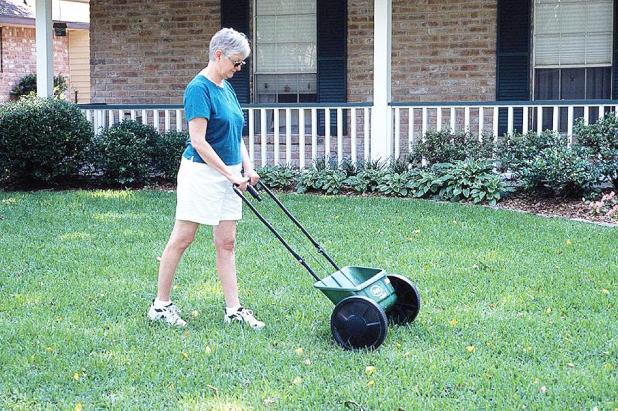
Using a drop spreader helps ensure an even fertilizer application.
—Dan Gil/LSU AgCenter photo
Get It Growing: It’s time to fertilize lawns
Fertilizing lawns in most of Louisiana is best done in early to mid-April. At that time our warm-season lawn grasses, such as centipede, St. Augustine, bermuda and zoysia, have begun active growth, reestablished a strong root system and are ready for the extra nutrients fertilization provides.
In many situations, fertilizing your lawn is optional. If your lawn has generally been healthy and attractive over the years with only occasional fertilization, you may choose to leave well enough alone this year.
Not that fertilization wouldn’t make a difference, I once convinced my dad to fertilize his front lawn, explaining that the grass would be darker green and grow better. A couple of months later he informed me that I had been right, but he had to mow it almost twice as often as the unfertilized backyard. This is added work, but a vigorously growing lawn is more resistant to weed encroachment.
Lawns that should definitely be considered for fertilization are those that in the past have sustained some damage that new growth needs to fill in, those that are thin or are poor in vigor and those whose owners desire a high degree of quality.
Because our lawns begin to green up in March, many gardeners wonder why we should wait until April to fertilize. Research shows that in early to mid-March our turfgrasses undergo spring root decline. At that time, much of the old root system dies, and the grass grows new roots.
So during March green up, turfgrasses don’t have substantial root systems even though the grass blades are beginning to grow.
If fertilizer is applied during this time, it can stimulate the grass to put its efforts into early leafy growth when it needs to be growing roots. So early fertilization can lead to the grass going into the summer season with a less-developed root system.
Besides, with fewer active roots present, the fertilizer will not be as efficiently absorbed. In addition, nutrients absorbed from early fertilization can make lawns more susceptible to spring infections of brown patch, a disease especially common to St. Augustine.
What type of fertilizer should you use? There certainly are plenty of them out there, and it can be confusing. Just remember that no one fertilizer is best; just about any commercial lawn fertilizer would do a good job fertilizing your grass. Check the label of whichever fertilizer you buy, and make sure that one-third to one-half the nitrogen is slow-release for extended feeding.
A fertilizer with an analysis that has about a 3:1:2 ratio would work fine. The ratio of a fertilizer’s analysis — the three numbers on a fertilizer package that tell you the percentages of nitrogen, phosphate (phosphorus) and potash (potassium) in that order — is found by dividing each number in the analysis by the smallest number of the analysis.
Fertilizers with a 3:1:2 ratio, such as 15-5-10, are also suitable for use on trees, shrubs and flowers as well as your lawn, which simplifies your fertilizer purchases. Fertilizers with similar analysis such as 16-4-8, 12-4-8 or 19-5-9 would also be suitable.
Most fertilizers formulated specifically for lawns, such as 18-0-18, or high-nitrogen fertilizers, such as 27-3-3, will produce good results with turfgrass but may not be as suitable for general landscape use.
It’s a good idea to apply fertilizer to a lawn that has been recently mowed. The shorter blades will allow the fertilizer granules to move down to the soil more efficiently. The fertilizer should be evenly broadcast at label-recommended rates.
Read the label carefully, and make sure you apply only the amount of fertilizer recommended. This is extremely important because overapplication can damage or burn the grass.
It is best to use a fertilizer applicator to get even coverage. The drop type applicator is recommended.
Apply half the needed amount of fertilizer in one direction (east to west), then apply the other half in the other direction (north tosouth). Spreading the fertilizer granules by hand often leads to burned spots and uneven growth. Apply the fertilizer to dry turf, and water it in thoroughly afterwards.
If you have a weed problem, you may use a “weed and feed” type product that includes a herbicide to kill the weeds as you fertilize. Make sure you read the label directions carefully and follow them closely because the herbicides in weed and feed can be damaging to other plants in the landscape (such as trees and shrubs) if not used properly. Also, make sure the herbicide in the product is safe to use on the type of lawn grass you have. Some herbicides that are safe to use on one type of grass may damage another.
Finally, if you know the identity of the weeds you are having problems with, choose a product which lists that weed as one it will control.
Remember that fertilizing turfgrass is something we do to increase the quality and vigor of our lawns and is not a matter of life and death. Bermuda lawns are most demanding of fertilizer and may be fertilized three to five times from April to August. Gardeners who wish to push St. Augustine or zoysia lawns to be their most vigorous can fertilize again in June and make a final application in August.
However, one additional application in July will be adequate in most situations. Centipedegrass, a lower-maintenance turf that requires less fertilizer than the other turfgrasses, is generally fine just fertilized once in April.
